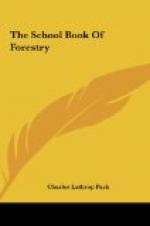CHAPTER V
IMPORTANT FOREST TREES AND THEIR USES
Of our native trees, the white pine is one of the best and most valuable. It is a tall straight tree that grows to a height of 100 to 150 feet. It produces wood that is light in weight and easy to work because it is so soft. At one time there were extensive pine forests in the northeastern states. Many of the trees were very large, and occasionally one may still see pine stumps that are 5 to 6 feet in diameter. White pine made fine lumber for houses and other buildings and this timber was among the first to be exhausted in the country.
Spruce trees have long furnished the bulk of the woodpulp used in making our supplies of paper. These trees live in the colder climates of the northern states. They like to grow in low, wet localities close to lakes or rivers. The spruces generally do not grow higher than 75-100 feet. The wood is soft like pine and even whiter in color. The aboriginal Indians used the roots of the spruce trees as thread, twine and rope.
The cedar trees, which are landmarks in many of our northern states, yield light, soft, durable wood that is useful in making poles, fence posts, lead pencils and cedar chests. The wood of the red cedar gives off a peculiar odor which is said to keep moths away from clothes stored in cedar chests, but it is the close construction of the chest which keeps them out. These trees are becoming scarce in all parts of the country. Cedars generally are small trees that grow slowly and live a long time. The outside wood is white and the heartwood is red or yellow. Cedar posts last a long time and are excellent for use in farm fences.
Chestnut blight, which destroys entire forests of chestnut timber, is gradually exhausting our supplies of this wood. Chestnut timber has long been used for railroad ties, fence posts and in the manufacture of cheap furniture. The wood is soft and brown in color. The bark and wood are treated at special plants in such a way that an extract which is valuable for tanning leather is obtained. Chestnut trees are upstanding, straight trees that tower 80 to 100 feet above the ground. The extinction of our chestnut forests threatens as no effectual control measures for checking the chestnut blight disease over large areas has yet been discovered.
The yellow poplar or tulip poplar furnishes timber for the manufacture of furniture, paper, the interior of railroad cars and automobiles. The dugouts of the early settlers and Indians were hewed out of poplar logs. These boats were stronger than those made of canoe birch. Poplar wood is yellow in color and soft in texture. The poplar is the largest broad-leaf tree in this country and the trees are of great size and height. Some specimens found in the mountains of the South have been over 200 feet high and 8 to 10 feet in diameter, while poplars 125 to 150 feet high are quite common.




